A well-maintained pond contributes to a thriving ecosystem, providing a balanced habitat for fish, plants, and other aquatic life.
Algae blooms, however, can disrupt this balance, turning water murky and depriving aquatic life of oxygen.
These blooms often result from excessive nutrients, prolonged exposure to sunlight, and stagnant water.
By taking proactive steps, pond owners can prevent excessive algae growth and maintain clear, healthy water. If you need professional assistance or advice, you can find it on this site.
Now, let us talk about effective strategies to prevent algae bloom.
Preventative Measures to Control Algae Blooms
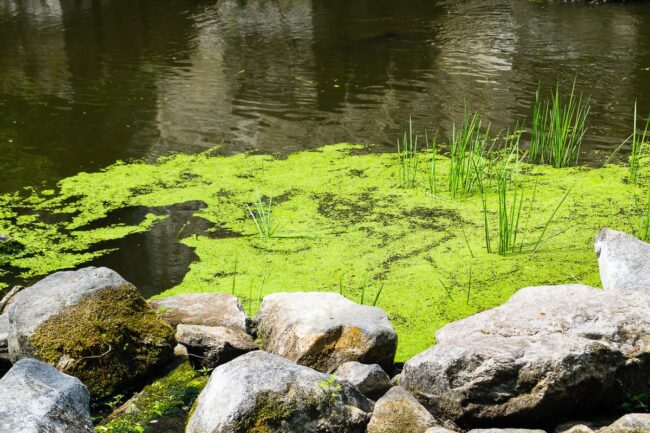
Preventing algae blooms requires a combination of proactive strategies that focus on improving water quality and limiting the conditions that encourage algae growth.
Key factors such as oxygen levels, nutrient management, sunlight exposure, and external pollutants play a major role in algae proliferation.
Addressing these factors effectively can help maintain a clear and balanced pond.
Improve Water Circulation & Oxygenation
Stagnant water provides the perfect setting for algae to spread rapidly.
Proper circulation disrupts stagnant zones, increases oxygen levels, and supports beneficial bacteria that naturally reduce excess nutrients.
Improving water movement not only reduces the growth but also enhances the overall health of aquatic life.
The following methods can help achieve better water circulation and oxygenation:
- Aerators and fountains continuously move water, keeping it oxygenated and preventing debris from settling at the bottom. Surface aerators are particularly useful in shallow ponds, while fountains add aesthetic value along with functional benefits.
- Submerged aeration systems push oxygen through diffusers placed at the pond’s bottom, distributing air evenly throughout the water column. This method is effective for deeper ponds where oxygen depletion is more common.
- Pond bubblers work similarly to aerators but provide a more localized source of water movement, preventing small stagnant pockets where algae thrive.
- Waterfalls or stream features: If the pond design allows, adding a waterfall or a small stream helps to keep water circulating while naturally oxygenating it.
Control Nutrient Levels
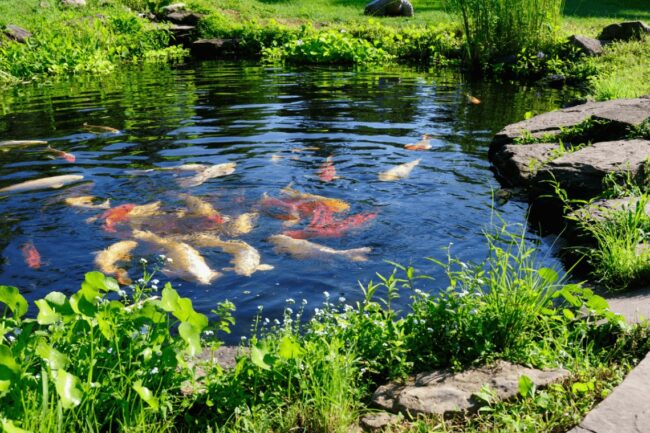
Excess nutrients, primarily nitrogen and phosphorus, are the main contributors to algae blooms. These nutrients come from organic debris, fish waste, lawn runoff, and decomposing plant matter.
Proper nutrient management is key to controlling algae levels. The following steps help regulate nutrient input:
- Leaves, grass clippings, and decaying plants introduce excessive organic material into the water. Removing this debris reduces nutrient accumulation that feeds them.
- Overcrowding leads to excessive fish waste, which releases nutrients into the water. Keeping an appropriate number of fish and avoiding overfeeding prevents unnecessary waste buildup.
- Using beneficial bacteria actively breaks down organic matter before it has a chance to convert into nutrients that support growth. Regularly adding beneficial bacteria helps maintain a cleaner pond.
- Limiting external nutrient inputs ensures that surrounding landscapes are free of excessive fertilizers and organic runoff minimizes additional nutrient loading into the water.
Reduce Sunlight Exposure
Algae thrive in direct sunlight, making it crucial to introduce shade solutions that limit excessive light penetration.
Shading strategies not only help block sunlight but also contribute to an overall more balanced pond ecosystem.
Several effective ways to reduce sunlight exposure include:
- Water lilies, duckweed, and lotus provide natural shade while absorbing excess nutrients.
- Taller plants growing along pond edges also contribute by blocking some of the sunlight from reaching the water.
- Shade sails, pergolas, or even well-placed pond covers can reduce sun exposure and lower water temperatures, making conditions less favorable for growth.
- Positioning trees or shrubs around the pond helps to cast shade over sections of the water, further reducing the conditions.
Manage Runoff & External Nutrient Sources
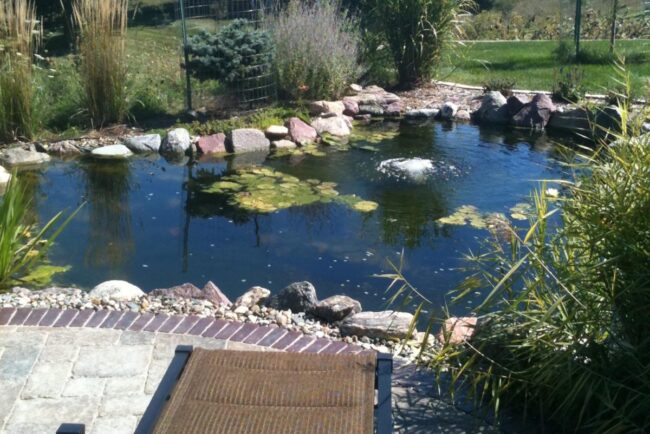
External pollutants and runoff introduce large amounts of nutrients into the water, significantly contributing to algae growth.
Managing these external sources is essential for maintaining long-term water clarity. The following measures help limit runoff contamination:
- Avoid applying fertilizers near the pond’s edge, as excess nitrogen and phosphorus can easily wash into the water, triggering growth.
- Sloping pond edges and installing proper drainage solutions prevent rainwater from washing excess nutrients and contaminants into the pond.
- Planting deep-rooted grasses, shrubs, and other vegetation along the perimeter acts as a natural filter, absorbing excess nutrients before they reach the pond.
- These specialized plant beds capture and filter runoff, reducing the introduction of pollutants into the pond ecosystem.
Use Natural Algae Inhibitors
Certain natural compounds and biological treatments help suppress algae growth without introducing chemicals into the pond. These natural inhibitors provide an environmentally friendly alternative for algae control. Some effective options include:
- When placed in water, barley straw decomposes and releases compounds that inhibit algae development. This method is widely used as a long-term algae prevention strategy.
- These beneficial microorganisms consume nutrients that algae would otherwise use, effectively outcompeting them for resources. Introducing diatoms helps create an ecological balance that naturally limits expansion.
- These products work by breaking down excess organic material, reducing the nutrients available. Regular applications help sustain cleaner water conditions.
- Snails and certain fish species, such as koi and grass carp, feed on algae and help keep its growth under control.
Treatment Options for Existing Algae Blooms
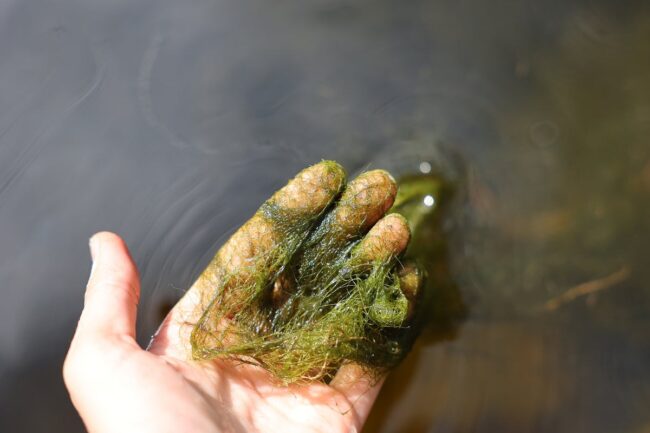
When algae blooms take over a pond, quick and effective action is necessary to restore water quality.
Different methods exist to tackle the problem, ranging from manual removal to chemical and biological approaches.
The best solution often depends on the severity of the algae bloom and the overall condition of the pond.
Below are three primary strategies for managing existing algae:
- Mechanical removal
- Chemical treatments
- Biological control methods
Mechanical Removal
Physically removing algae is often the quickest way to reduce its presence. This method prevents floating and organic debris from decomposing, which would otherwise release nutrients back into the water and fuel further growth.
Several tools and techniques can help with this process:
- Manual removal using nets or skimmers helps eliminate floating algae before it settles and decomposes. This method is particularly useful for filamentous algae that form mats on the surface.
- These devices remove organic sludge that accumulates at the bottom, reducing nutrient buildup. Sludge often consists of decaying plant matter, fish waste, and organic debris.
- Installed along the pond’s surface, skimmers continuously collect floating debris, reducing nutrient availability and preventing algae from taking hold.
- For ponds experiencing excessive growth, raking or dredging can be used to physically remove large amounts of biomass, preventing it from decaying in the water.
While mechanical removal provides immediate results, it is often a short-term fix. Without addressing the underlying causes of algae blooms, new growth can quickly return.
Chemical Treatments (Use with Caution)
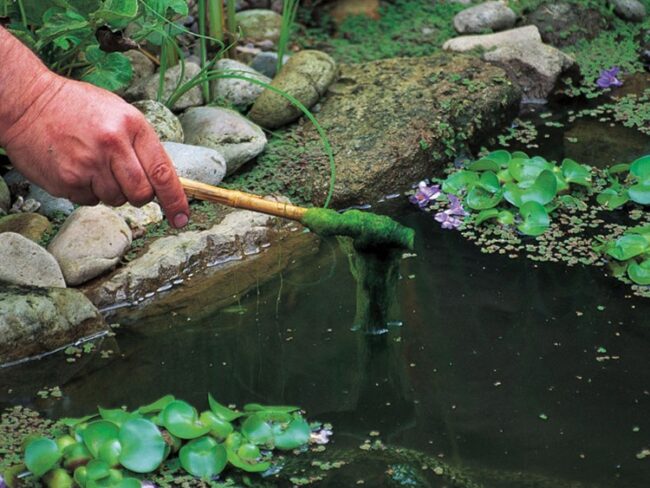
In cases where algae have spread extensively, chemical treatments may be necessary. These should be used cautiously to avoid unintended consequences such as harming fish, plants, or beneficial microorganisms. The most common options include:
- Copper-based algaecides treatments effectively kill various types, including planktonic, filamentous, and blue-green algae. However, overuse can lead to copper buildup in the pond, potentially harming fish and other aquatic life.
- A safer alternative to harsh chemicals, hydrogen peroxide oxidizes algae cells, breaking them down without leaving behind harmful residues. This treatment is effective for localized outbreaks and can be used in ponds with fish and plants.
- Some aquatic herbicides specifically target algae without affecting other plant life. These should only be used when algae are threatening the balance of the pond’s ecosystem.
When applying chemical treatments, it is essential to monitor water quality closely. Overuse can lead to oxygen depletion as decomposing algae consume available oxygen, potentially causing harm to fish and other aquatic organisms.
Biological Control Methods

Introducing natural algae consumers and beneficial bacteria offers a long-term strategy for managing blooms. This approach works by reducing excess nutrients and outcompeting algae for available resources. Key biological methods include:
- Certain species, such as koi and grass carp, feed on algae, helping to control excessive growth.
- Adding bacteria that break down organic waste can significantly reduce the nutrients available to algae. These bacteria help decompose fish waste, plant debris, and excess nutrients, improving water clarity and overall pond health.
- While not direct algae consumers, aquatic plants such as water lilies and duckweed absorb excess nutrients, limiting the resources that algae need to thrive.
Biological controls work best when combined with other preventative measures. Regular water quality monitoring and maintenance ensure that beneficial organisms continue supporting a balanced ecosystem.
The Bottom Line
Preventing algae blooms requires a proactive approach that focuses on nutrient control, circulation, shading, and natural inhibitors.
By addressing algae before it becomes a major problem, pond owners can maintain clean and balanced water throughout the year.
A well-planned maintenance routine ensures long-term success, reducing the need for reactive treatments.
